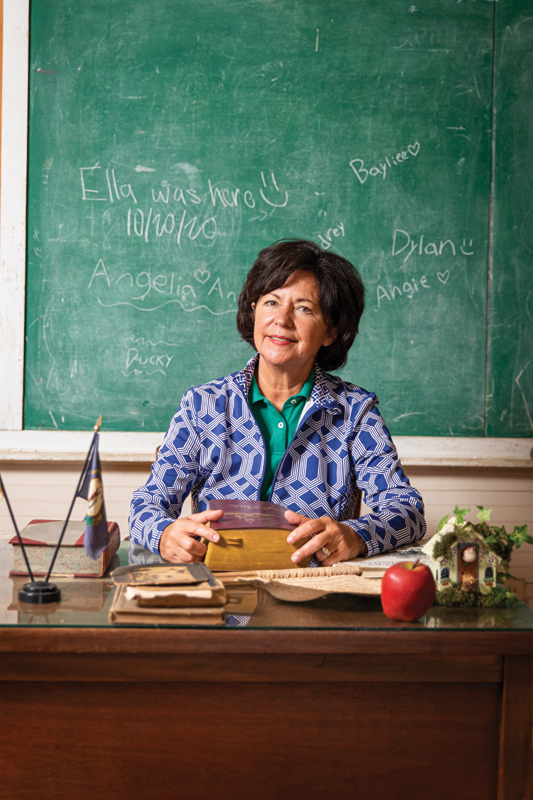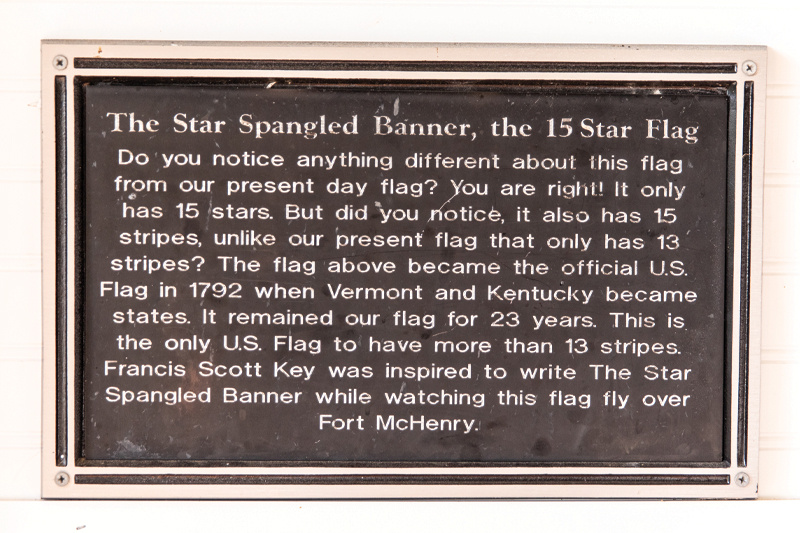Photos by Jamie Alexander
If you listen intently, with your imagination intact, you can hear the excited echoes of a schoolroom full of local children—cheerful boys’ and girls’ voices, papers shuffling, the clatter of wooden desks opening and closing, and one very attentive teacher encouraging students to find their seats before explaining the day’s reading assignment.
That was then. This is now.
The excitement remains, yet it is a voice of discovery or remembrance fashioned either as a mini history lesson or in the retelling of stories that their parents or grandparents told them about their good ol’ days. Visitors to Panther Creek Park enjoy seeing, exploring and explaining to their children the visual connection to the past found in the restored and relocated Pleasant Grove Schoolhouse, one of the oldest, functional buildings in the state.

“When the park is open, the doors are usually open,” Marcia Carpenter said. In the last few months, she and her brother, Rod Kuegel, did renovations that created an exterior glassed viewing area of the interior of the schoolhouse. Prior to that, the schoolhouse was typically locked, and potential visitors had to set up a time to have it opened for viewing. “It’s fun to be out here and see some families come visit and tell the story,” Marcia said. Their mother, Carrie Kuegel, spearheaded the original restoration of this one-room schoolhouse which she attended through fifth grade. “Mom wanted to restore it because it was just falling down, and she wanted people to remember the history that was there because she had such great memories,” Marcia said.
Pleasant Grove School was built in 1876 and sat alongside old Sorgho School and Pleasant Grove Baptist Church on Kentucky Highway 56. Used as a school for 60 years, it was converted to a residence in 1936 for the custodian of the then-new Sorgho School. Mrs. Kuegel orchestrated the relocation of the building to Panther Creek Park in 1996 and enlisted the resources and help of many for its restoration—the County Judge, the Historical Society, Joe Ford and inmates. “She would go pick up people from the County Jail and bring them here herself in the pickup to help her with the work,” Marcia said. The whole process took about two years.
According to old documents, Pleasant Grove School “consisted of one-room with a pot-bellied stove in the center of the structure for heat.” The wooden structure had four large windows on each side and was about 28 feet wide by 42 feet deep, double doors in the front and a single door entrance in the back, with an outhouse nearby. Grades 1-8 attended.
Mrs. Kuegel not only worked on refurbishing the physical structure but also restoring the furnishings of the schoolhouse, locating wooden student desks in graduated sizes (going from small to larger), a pot-bellied stove, coal box, chalk board, coat hooks, lunch pail shelving, teacher’s desk and even McGuffey Readers—not original to the school, yet original to the school’s time period.
As Marcia explained, the school has previously been the target of vandals and has had uninvited occupants. Now, the doors to the schoolhouse are locked at night and opened each morning, allowing the park personnel to easily check the overall condition of the building from the new glassed viewing area.

In the early 1930s, she said that many of the 88 smaller schools in Daviess County (such as Pleasant Grove School) were consolidated into larger schools, like Thruston, Sorgho, Utica, Maceo, Masonville, Seven Hills, Philpot, etc. “People were not pleased to have to give up their school because there was a lot of local control with schools like this, and most of them sat beside churches, and so they were very selective in whom they chose to come teach . . . and they really had quite a bit of control over what was taught and all that went with it. If there was work that needed to be done, the community did much of it, and the very first school bus was run by Mr. Lockhart Riddle (grandfather of Charlotte, Billy and Allan Reid) in about 1926,” Marcia said. That consolidation created a greater need for transportation, compared to the small local schoolhouses which were no more than a two-mile walk or horseback ride for students.
The most recent restoration is actually the second for Marcia and Rod. “We just wanted to find a way for the school to be used. Now, I think it is,” Rod said. In 2019, more extensive repairs were needed, like bolstering the pine floors, which had collapsed.
Walking inside the schoolroom, photos from that era are hung on the walls to give a greater sense of the late 1800s and 1900s, including group photos of school children and teachers in floor-length skirts. Former Daviess County Judge Executive Buzz Norris’ mom actually taught at Pleasant Grove. A Bible, often read and taught, lay on the teacher’s desk, alongside a classic red apple. Other pictures confirm the poor condition of the school from having sat unused and unoccupied for many years. “We thought she had taken on too much, but that was not unusual for her,” Marcia said in regard to her mom’s idea to embrace such a massive restoration project.

With the homeschooling and NTI which have occurred throughout the COVID pandemic, parents can better relate to some of what took place within the one-room schoolhouse.
“One of the unique things that happened was the traditional learning that went on from [exposure to] the older ones. Mom, in particular, said she learned cursive before she learned to print. She won the Courier-Journal State Spelling Bee because she would sit there and listen to all the rest of them spell,” Marcia said. Mrs. Kuegel’s pretty penmanship remained notable throughout her adult life.
“Mom was so little, and her older brothers and sisters were in school, but when she first came the teacher thought she was just visiting, and so she sat in the teacher’s lap and brushed her hair,” Marcia said, laughing heartily as she recalled that story about her mom’s earliest school days.
She reiterated the important role of studying history so that we can glean the good and not repeat the bad. “With so much repetition in early schools—the read aloud, spell aloud, do the math aloud—that kind of rote learning still has some value in today’s schools,” Marcia said.














